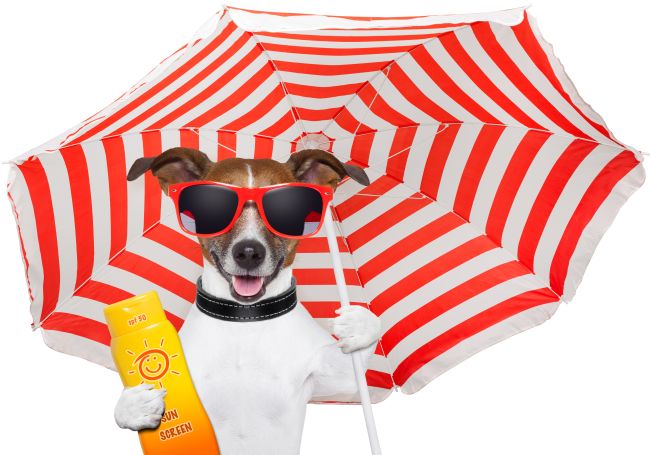
Like humans, cats and dogs suffer from sunburn when their skin has unprotected contact with the relentless rays. Sunburn can cause rashes, blistering, dehydration and peeling skin that may result in infection. Though many people are unfamiliar with the dangers of sun damage that can affect pets, the threat remains. Fortunately, proactive pet owners may see the harm ahead of time, and make subtle changes to their routines in order to protect their dog or cat from any discomfort.
Apply Sunscreen or Sun Block: This is the obvious answer about how to protect your pet from the sun. The products have a minor distinction: sun block rests on the skin’s surface, reflecting the light away from the body, while sunscreen is absorbed into the skin and is usually less visible. When trying to decide which to use, consult your vet with any questions.
First test the sunscreen on your cat or dog’s skin the day before you plan to apply it across a greater area. Make sure they are not allergic and that the skin does not become agitated in any way.
*NOTE: DO NOT use Zinc Oxide sunscreen, which can be found in most sun block products (usually not in sunscreen). Though it is highly effective in humans, the zinc can be toxic to pets if ingested. It is always best to error on the side getting a product designed specifically for pets. These can come in sprays, foam rubs, SPF face wipes, or sunscreen sticks to apply to the area that has the greatest sun exposure.
Build Shelters: If your dog or cat prefers to spend plenty of time outside, be sure that you provide some sort of shelter for them. A dog house would do the trick (as long as it has good ventilation so the pet won’t overheat). A shaded area with an umbrella, or even a crate cage covered with a blanket would give your pet a place to hide from the sunshine. Always ensure that water is accessible by the shaded area so they don’t suffer from dehydration.
Don’t Leave Your Pet Outside: There are many safety (and health-related) reasons why cats and dogs should be kept as indoor pets. Not only would being inside help regulate their body heat from extremes, but it also decreases the sun exposure and long hours of outdoor exhaustion. If your pet is playing outside, you should be there too. Likely as not, when you have had enough and are ready to come in, they will be right there with you.
Increase Antioxidants. Recent studies showed that humans who increased their intake of antioxidants suffered from less sun damage or burning than people who spent the same amount of time exposed to the rays. By increasing your pet’s intake of healthy nutrition and antioxidant-rich foods, the pet’s body will be fortified from within. *NOTE: This is not a sufficient protective measure when applied alone. Antioxidant supplements will only help protect, and should be used in conjunction with other ways to guard pets from the sun.
Avoid Grooming Them Close to the Skin. Next time you are at the groomers, or giving your pet a haircut, try to leave a fair amount of hair to protect the skin from getting burned. In the summer we always want to trim the hair close to the skin to lower our dog or cat’s temperature by shortening the coat. But if you know they will be in the sun often, don’t cut it so close.
Put on Sun-protective Clothing. Hairless breeds like Sphynx cat or American Hairless dogs benefit from being clothed with UV-blocking material. This also works well for animals that have allergic reactions to sunscreen. With full-body coverage to jackets hiding large areas of skin, these light-weight, light-colored garments act as an effective shield from the sun.

